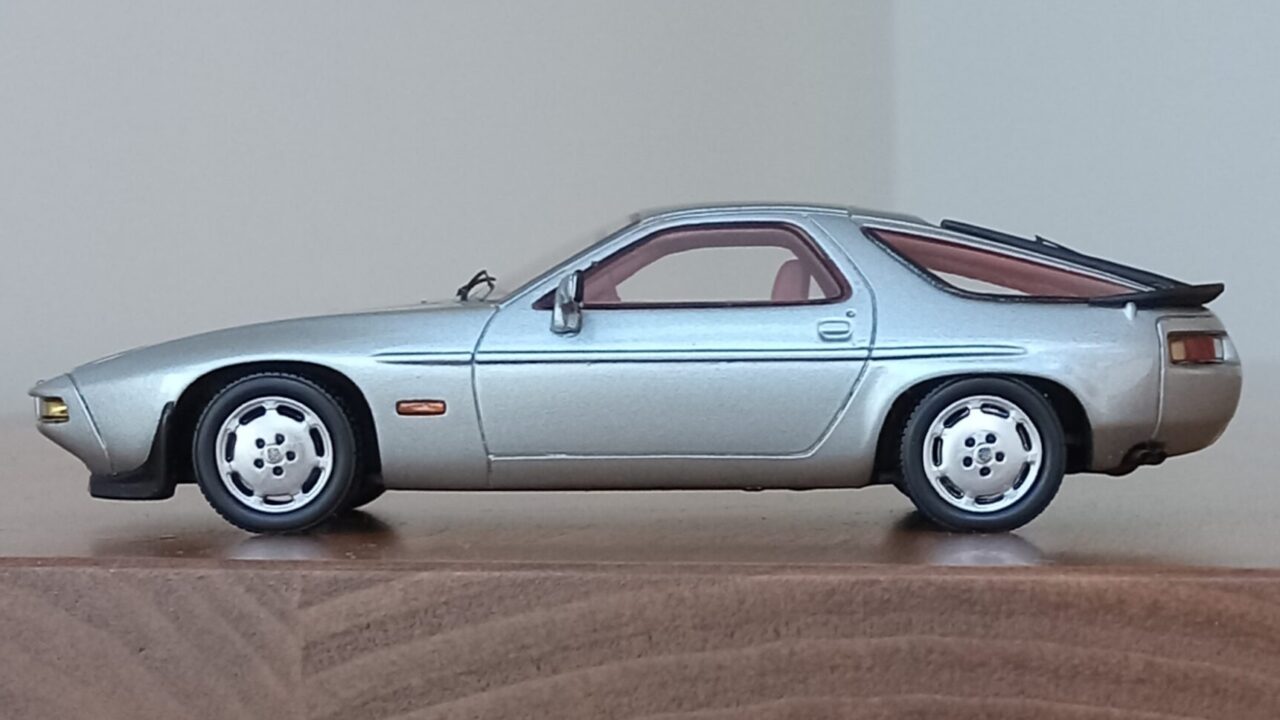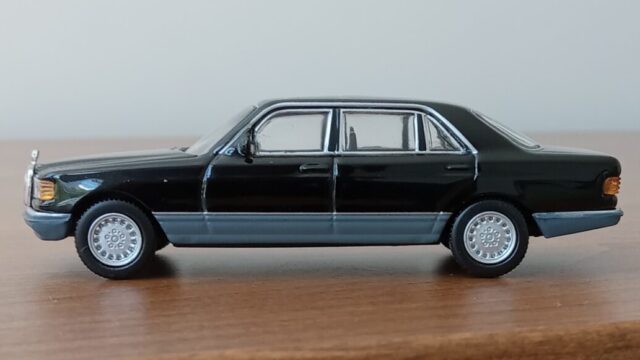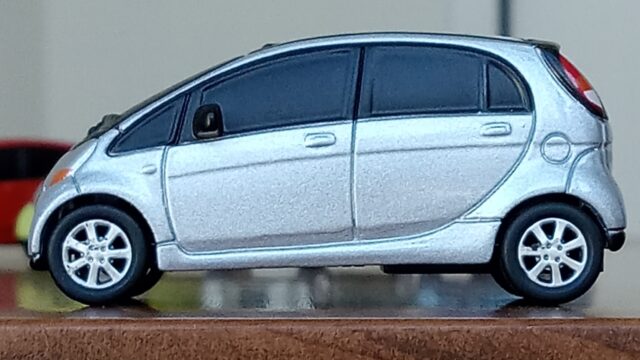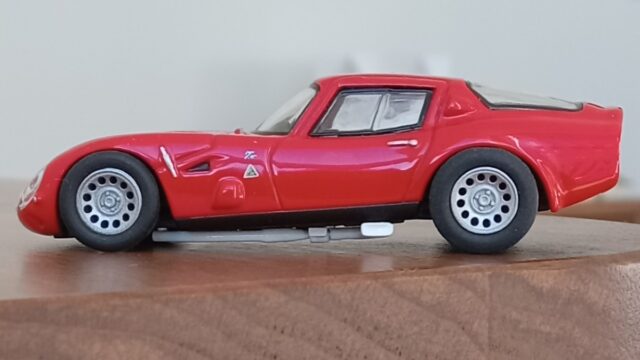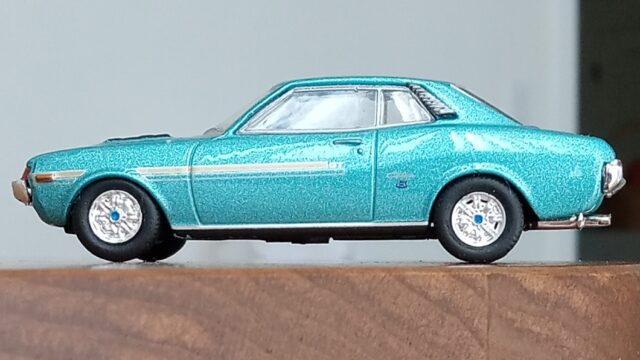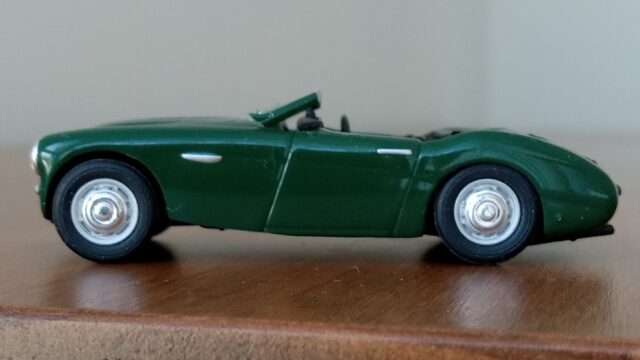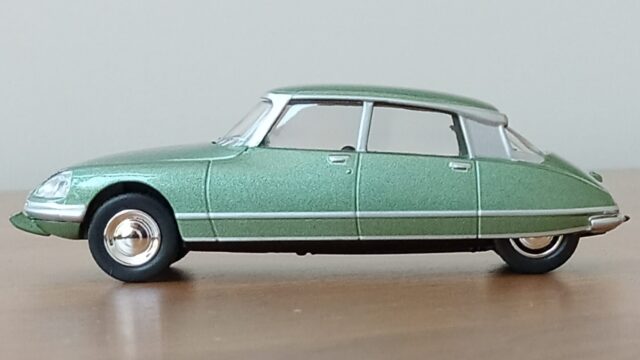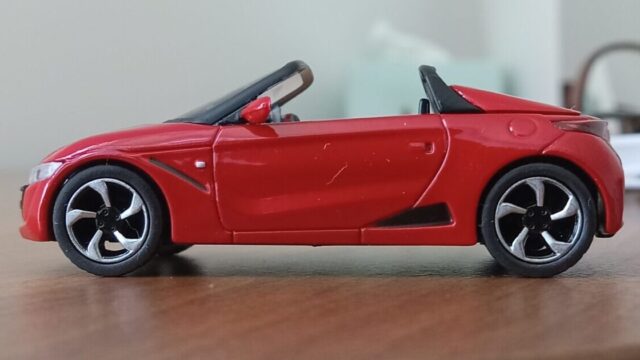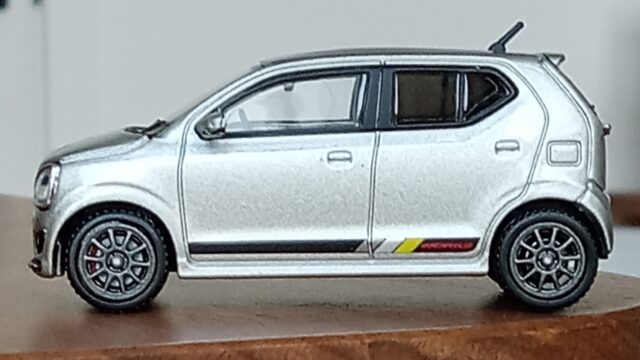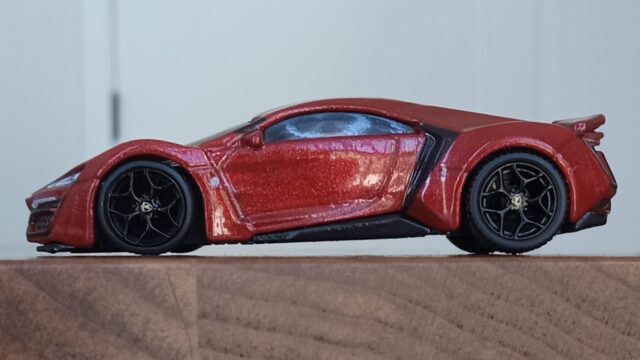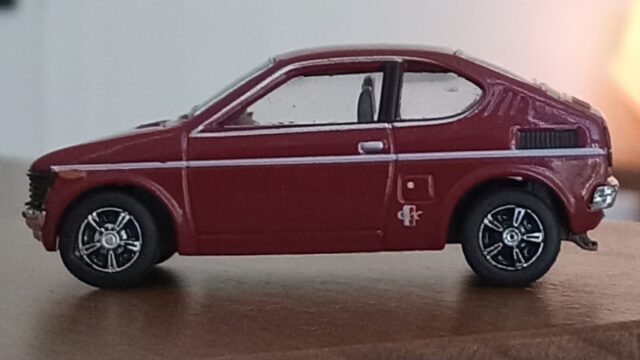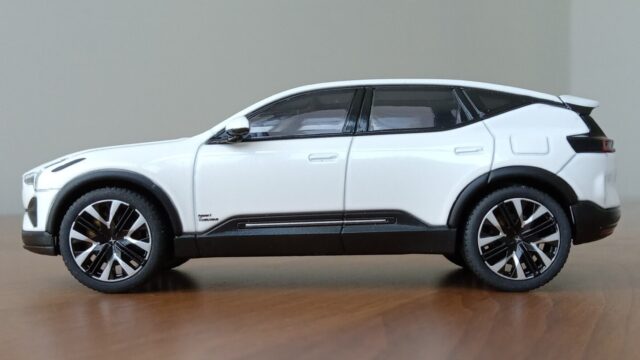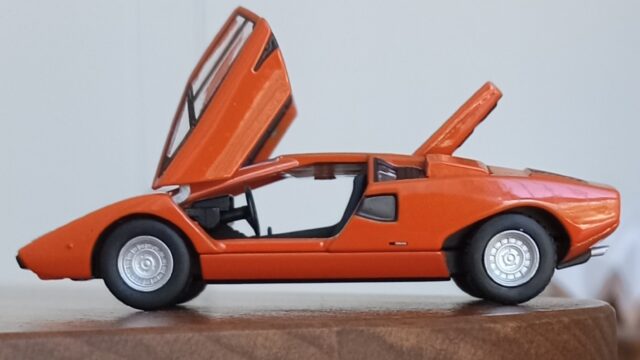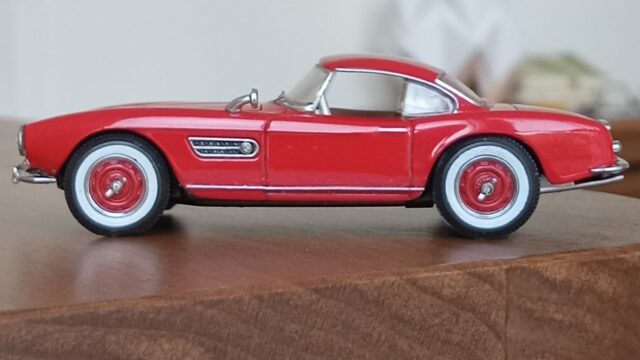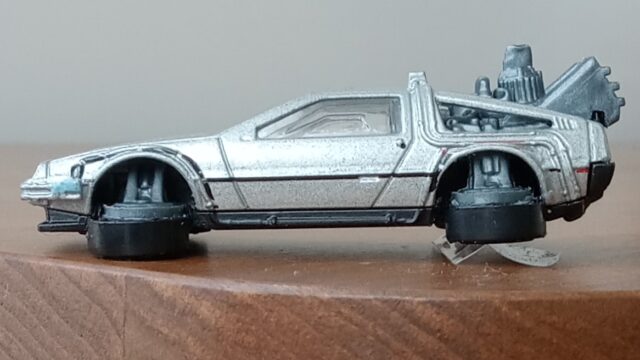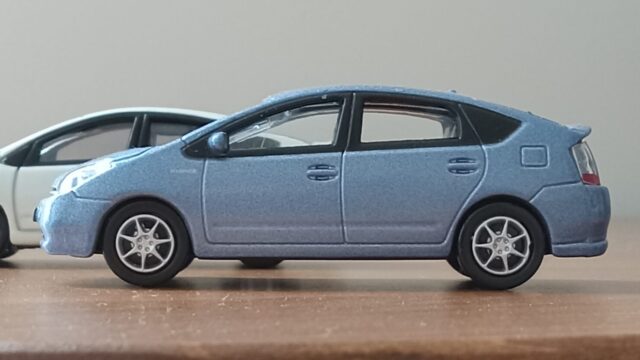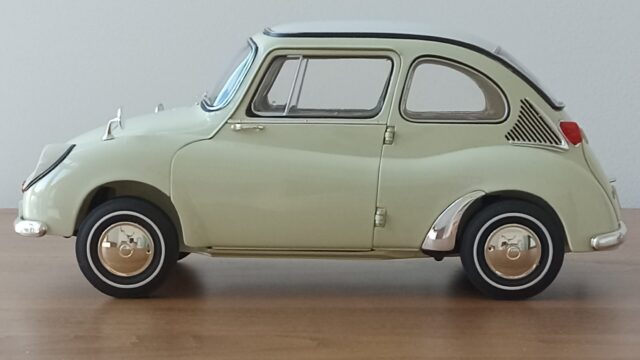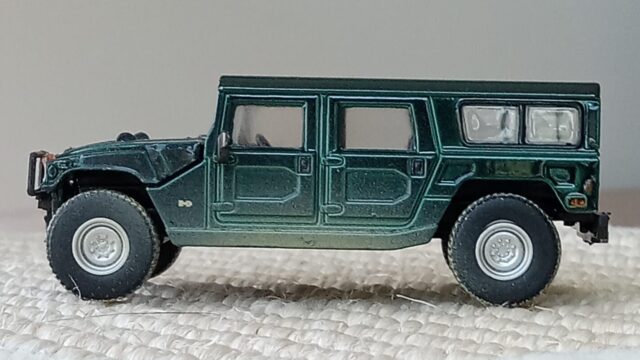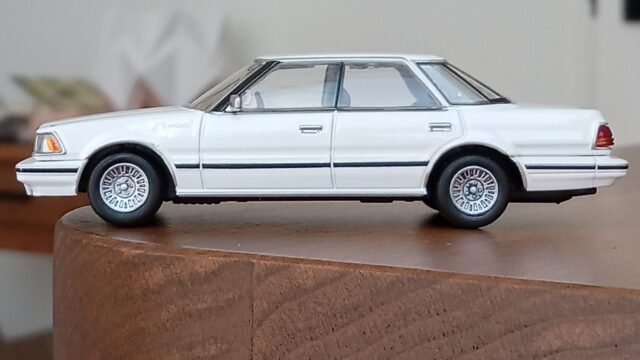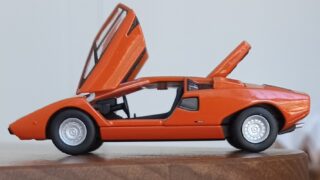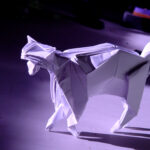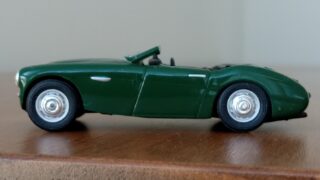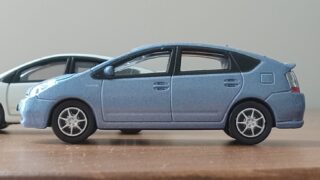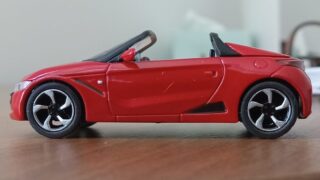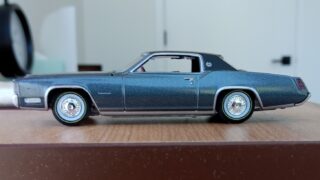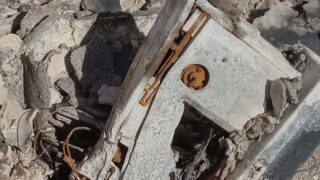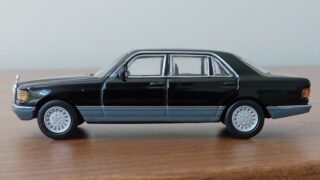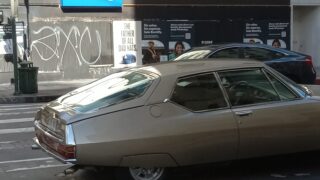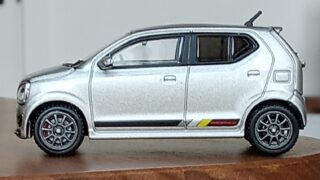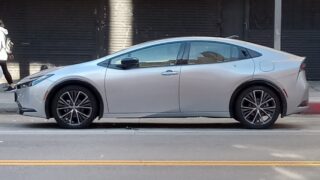デザイン・ベスト10リスト
こちらが私の独断と偏見による(笑)、
自動車デザイン・ベスト10リストとなっております。
第10位:BMW 507, 1956 ————————ーーー(シルバー+同色ハードトップ)
第9位:AMゼネラル ハマーH1, 1992 ——ー(軍用ウッドランド・カモフラージュ)
第8位:MB 560 SEL, W126型, 1979 ————ーー(黒とブルーグレーの2トーン)
第7位:キャデラック・エルドラド,1967 (メタリック・ブルーに黒のレザートップ)
第6位:トヨタ プリウス, 2003 (2代目)————————–(シーサイド・パール)
第5位:ホンダ S660, 2015 ————————————— (スター・ホワイトパール)
第4位:ポルシェ 928,1978 ————-(ライトブルー・メタに格子パターンの内装)
第3位:シトロエン DS23 Pallas, 1973 ————————(シャンペーン・ゴールド)
第2位:ランボルギーニ・カウンタック LP400, 1974 ——————ーー (オレンジ)
第1位:オースチン・ヒーレー 100/4 (BN/1), 1953 –(アイボリーと濃紺の2トン)
今回は第4位の、ポルシェ928,1977年型についての一般評価と私個人の928体験に付いて語らせていただきます。(写真の模型はすべて、928S型となっております。適当な928の模型が見つかりませんでしたので、あしからず。)
第4位:ポルシェ 928、1977
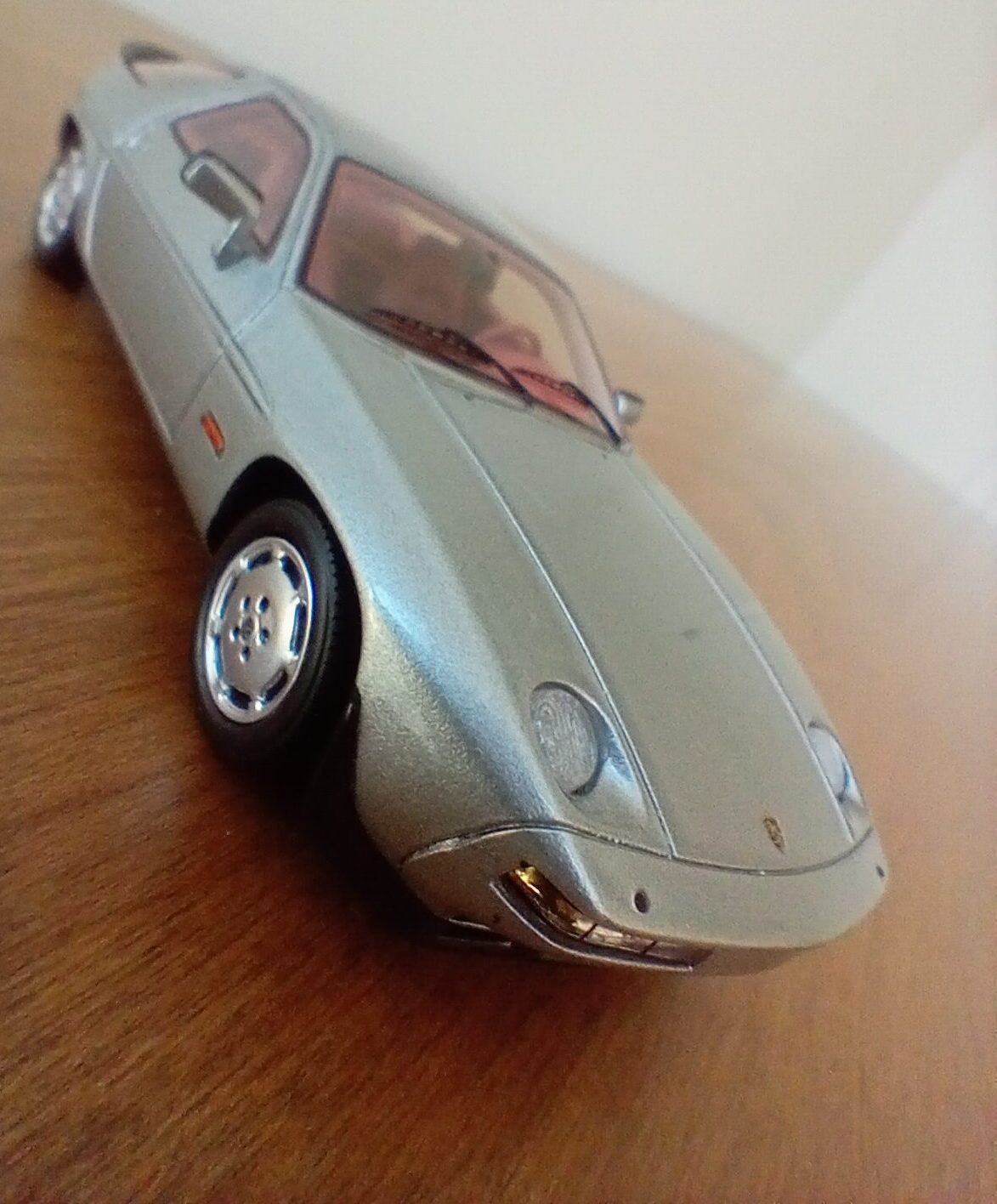

私の頭の中では、
ポルシェ928を思い浮かべるたびに、
『宇宙では、あなたの叫びは、だれにも聞こえない!』
と言う、20世紀フォックスの宣伝文句が渦巻きます。(笑) それは、リドリースコット監督の恐怖の名作SF映画、「エイリアン,1979」のキャッチフレーズなのですが、
その映画に登場する、
エイリアンの頭部の『ヌメヌメ感』と、
ポルシェ928のボディー上面の『ヌメヌメ感』が、
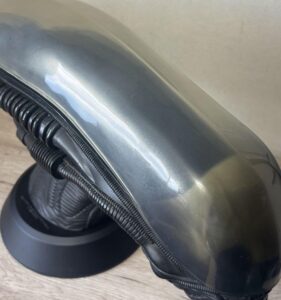
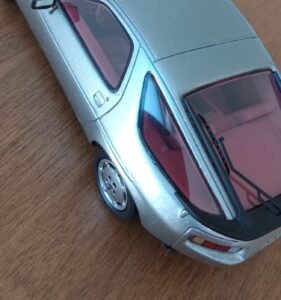
私の中で、
ほとんど同じもののように感じられるからです。
それほどに私の中で928は
異星人的な魅惑感と,
んんんんんんんんんn好奇心をそそられる存在です。
日本語も、英語も通じない、
得体のしれない地球外生命体との遭遇は、
私にかつてないレベルでの成長を促し、
新たなデザイン言語の習得と、
自分の中に潜む、
んんんんんn『異界の発見』に至らしめました。
実車解説:911に代わる?新世代の異端児
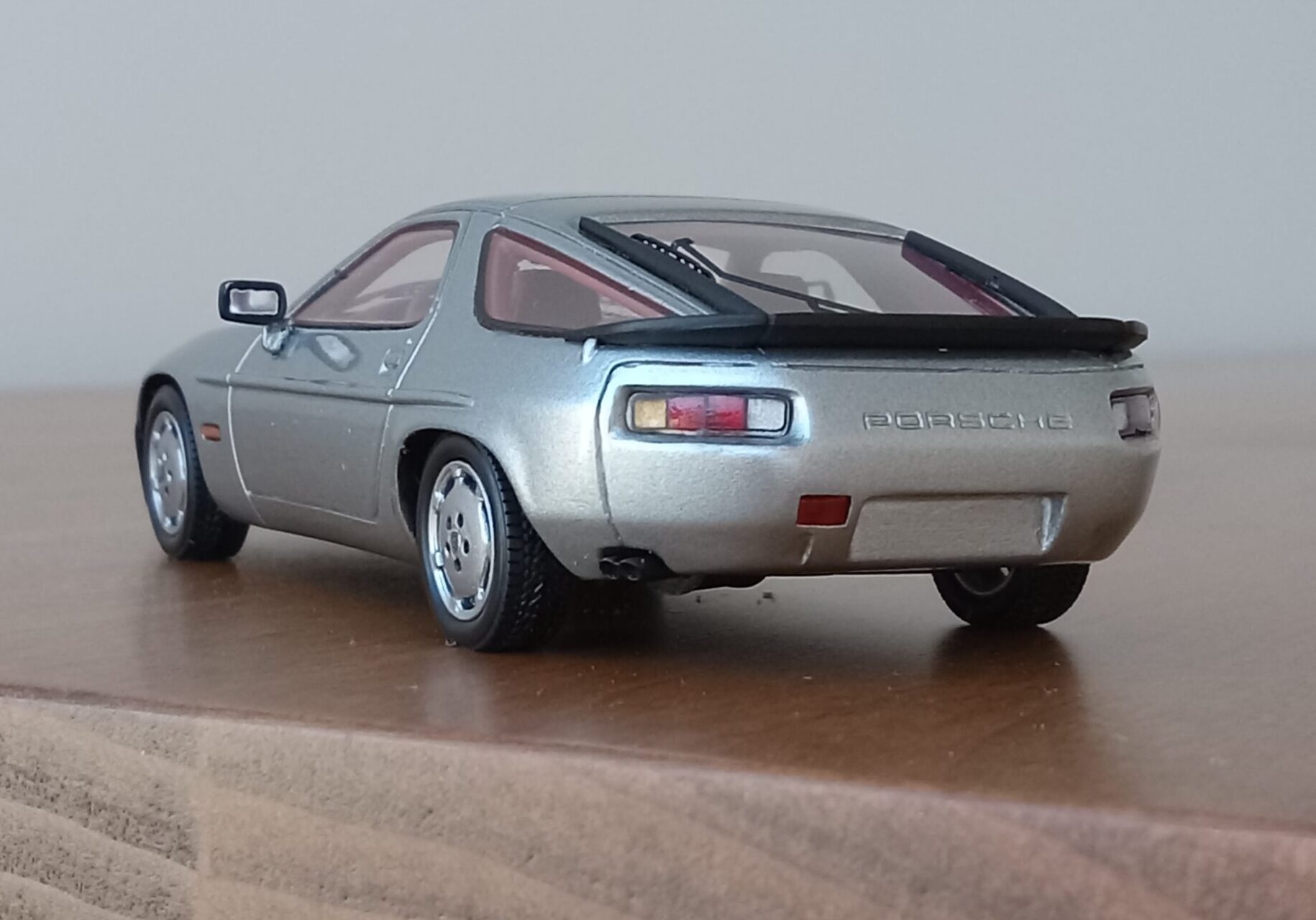 (SPARK製 1/43 Porsch 928S (Silver)ポルシェ博物館 Special バージョン)
(SPARK製 1/43 Porsch 928S (Silver)ポルシェ博物館 Special バージョン)
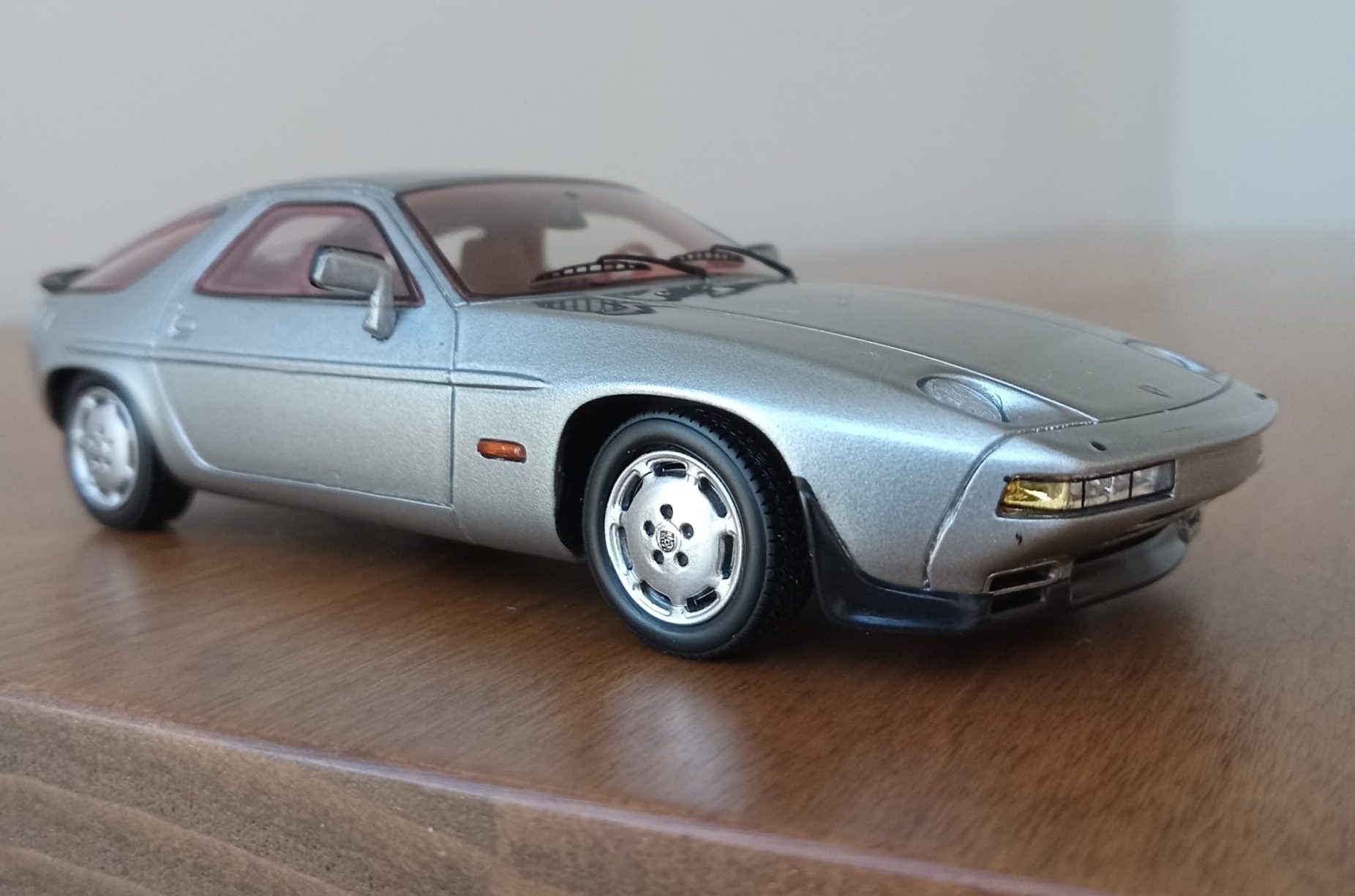
1972年、ポルシェとピエヒ一族が一時的に経営の一線から退く中、遠くアメリカ、ミシガン州のGMデザイン・スタジオにてビル・ミッチェル指揮下で、ラリー・篠田とともにデザインを担当していたアナトール・ラパインがポルシェに招かれ、彼の指揮のもと1977年にハーム・ラーガイとヴォルフガング・メビウスの共作という形で、928が発表されました。
彼らが作り上げた外観デザインは、リアエンジン・リア駆動のスポーツカーである911型(928以前の看板モデル)とは全く異なる、フロントエンジン・リア駆動のレイアウトを使い切ったロングノーズ・ファーストバックのハッチバック車となりました。具体的には、当時は聞きなれない(滑らかな曲面で構成される)オーガニックフォームをボディー全体にまとい、まるで、『地球外生命体』といったほうがいい様な、誰も見たことも、想像したこともない大胆かつユニークな出で立ちで登場、見る者を徹底的に刺激しました。
928は機構的にも最新技術の見本市状態となり、高度なリア・サスペンション:『ヴァイザッハ・アクスル』、トランスミッションのリア・アクスル化(バッテリもここに搭載)、ステアリングコラムごと上下するチルトシステム、未来的『T』字型のコックピット・デザインとドア側空調吹き出し口など、後の世のスタンダードを数々生み出しました。
結果的に、ポルシェ928は1978年度の『ヨーロッパ・カー・オブ・ザ・イヤー』を受賞(スポーツ・カーの受賞は928が唯一)、その後18年間にわたり、延べ61,056台が生産されました。その先進的な外観と、凝りに凝った機械機構を愛するファンは世界中に存在し、コレクターや愛好家の元で、現在も元気に走り回っています。
選考理由:客観的にみて、、、
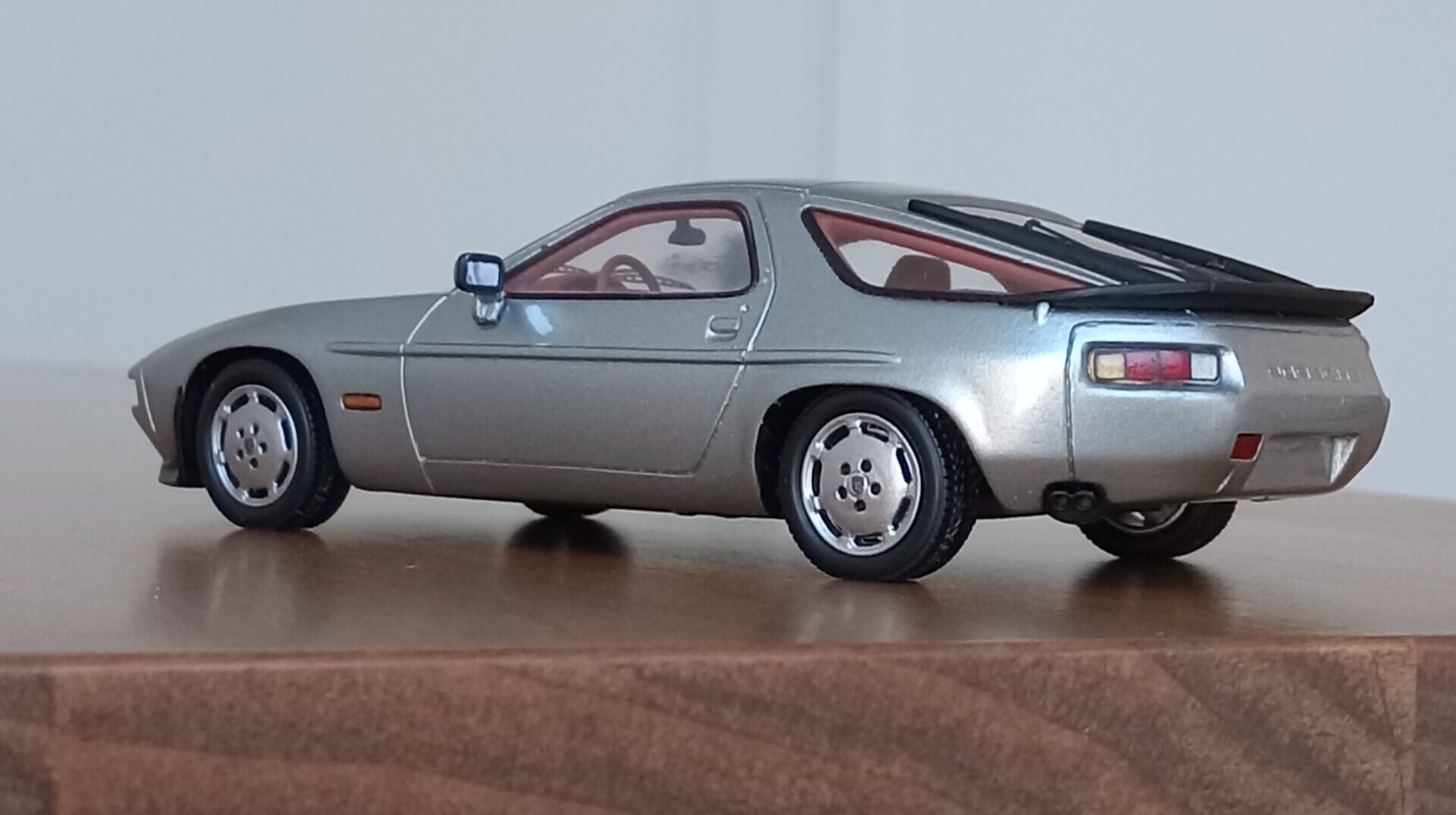

ポルシェ928の外観を細かく見ていきますと、
以下のような(破天荒でゲテモノ的な)デザイン的特徴がありました。
*90年代の流面形:
オーガニック・デザインの先駆けとなった外観の面造り
(80年代のCD値のこだわる第2の『空力・流線型』ブームに10年、先駆けた「ヌメーッ」としたボディー面の造形)
*前後でキャラが全く異なるプラン・ビュー(真上から見たカタチ)
ーーーーーー>
前からは、:強烈なシャーク・フェイス
(フロントフェイス前端を逆スラント気味に「スパッと」切り落とした姿+無機質な奥まったひとみ、の組み合わせ=クジラ・フェイス)
後ろからは、:立体的な異星人のマスク姿?
(新素材のウレタン系素材で包まれたバンパーとテールライトをまとめ上げる形で造形された、一目で記憶に残る、印象的で、きわめて独創的な立体造形)
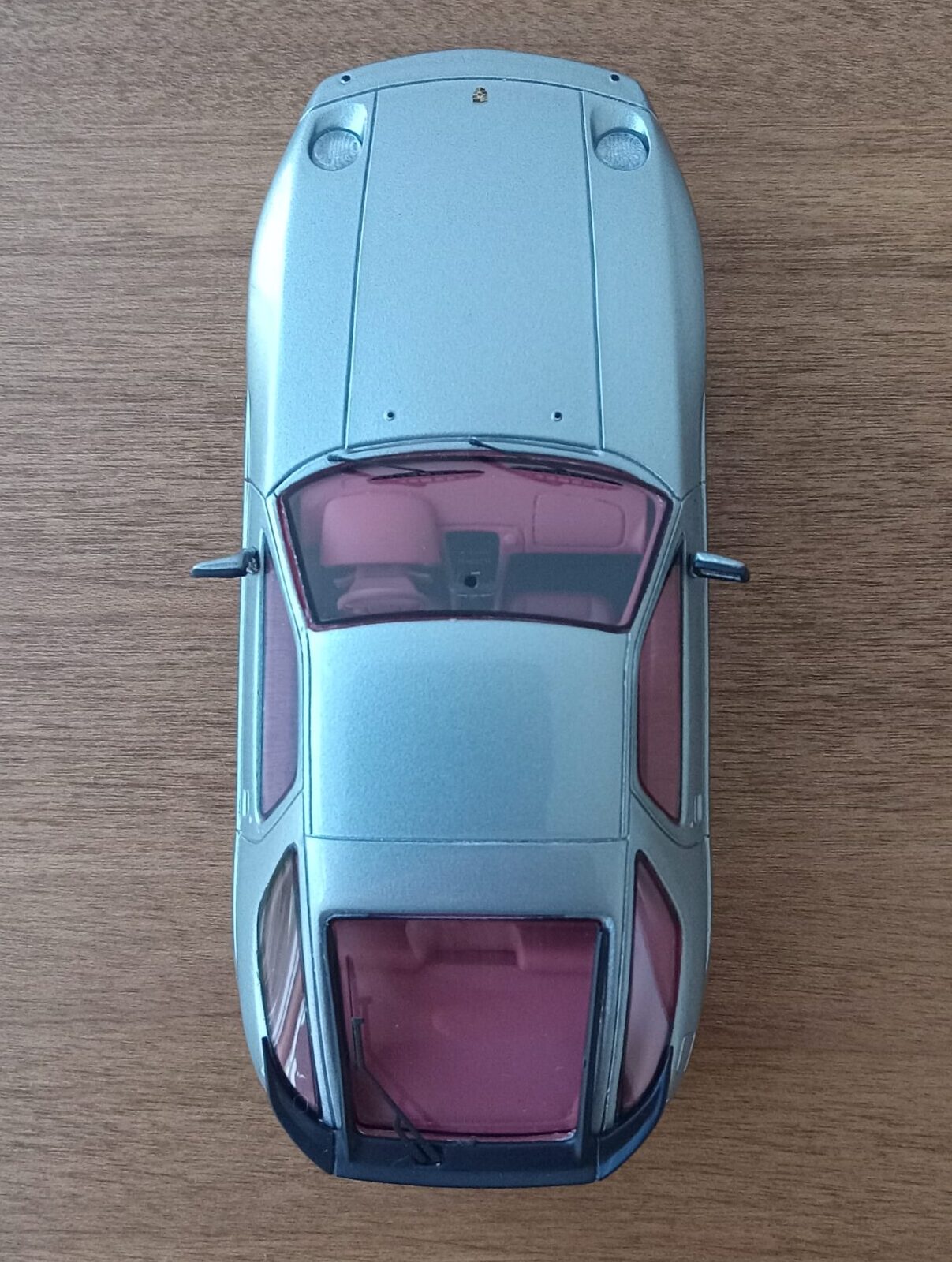

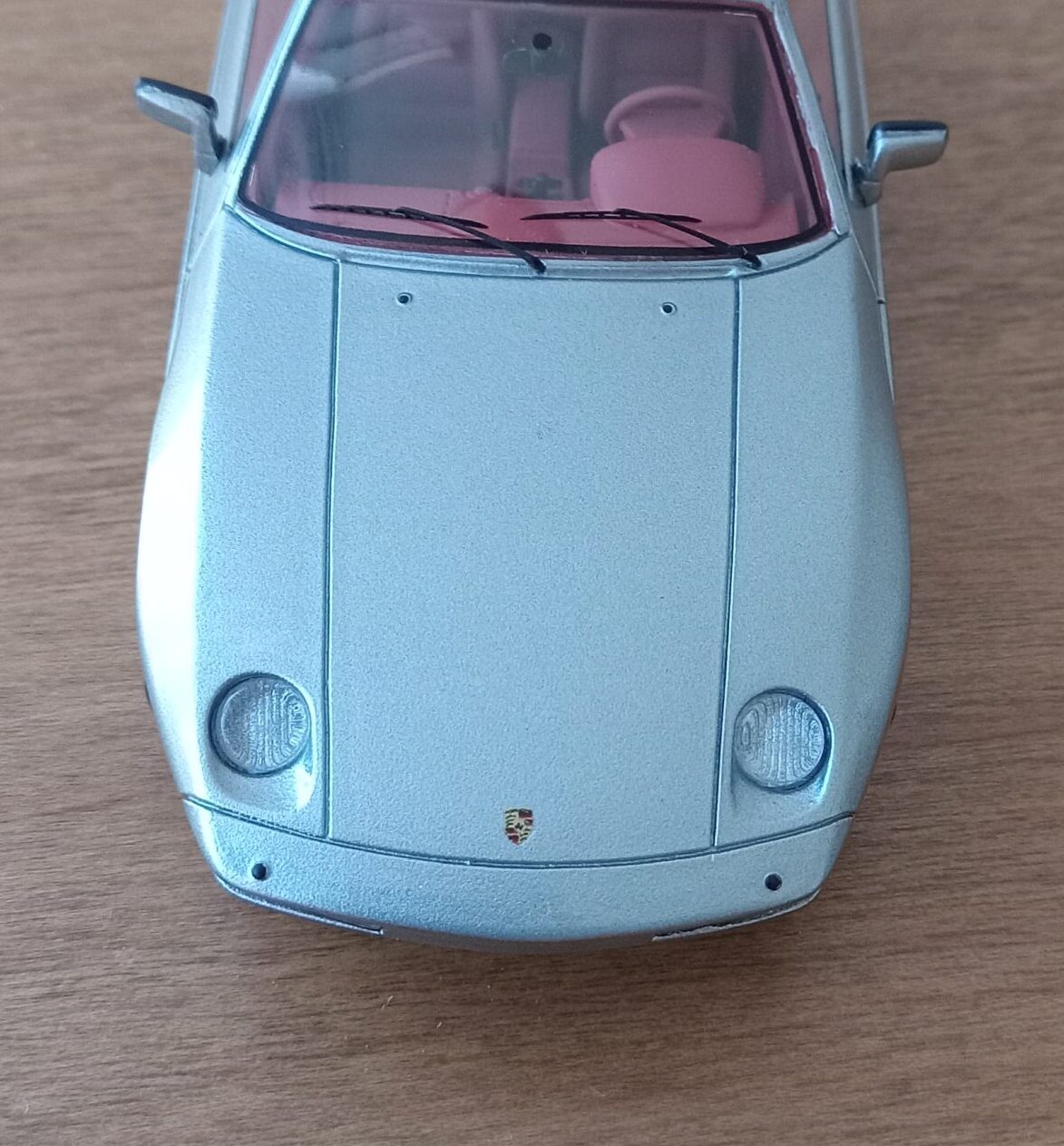
*カブト虫の外羽のような、
テール部分を外側からやさしく包み込む、リア・クオーターウインドウ
(ほかには、AMC/ペーサーのリアウインドウぐらいしか例がない?)
*台形のデザイン・モチーフ
(ボディー全体にあふれかえる、台形モチーフ:バンパー・ライト、フロント・ウインドウ、サイド・ウインドウ、ドアミラー、テイルライトなど)
*言い尽くせないほどのインテリアデザイン・モチーフのあれこれ。
#チルト式メータークラスター
#T字型で伸びやかにセンターにつながる包まれ感に富む、コックピット造形
#斬新なチェック柄のシート素材選び
#超分厚いドアにダクトでつながるエア・吹き出し口
(後の、フェアレディーZ やホンダ・プレリュード,NSXなどのインテリアデザインに影響を与える。)
私と928:グンゼと田宮のプラモで綴る私的物語
私とポルシェ928との出会いは
スーパーカーブームで始まった、中学生時代、
田宮とグンゼのプラモデルとともにありました。
幼いながら、その理解不能な立体物を毎日手に取り、
『何とかして自分の好みの角度を見つけたい』一心で、
いろんな角度から眺めて、悶々とする中で、
それまでサイドビュー一辺倒だった(平面的)視点を一気に、
360度、いや、天空義的な、全位相方位に対しての立体的、
んんんん そう、ユニバーサルな視点 の存在に至らしめたのです。
*まず初めに手にしたのは、
TAMIYA製, 1/20のメタリックブルーの箱絵のもの、

こちらは1/20グランプリコレクションとしての発売で、それまで一般的だった、1/24キットに比べて2倍近いボリュームがあり、ただでさえ手触り甲斐のあるボディーの量感が一層素晴らしく、毎日寝る前に触りまくったり、見まわしたりして、独りで「組まず語り/ランナー・ジュース(酒の代わり)」していました。(笑)
*次に入手したのが、
グンゼ産業の力作:1/24のデラックス・シリーズ?の928で
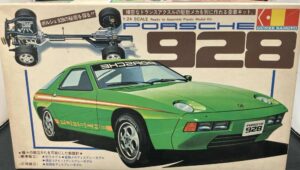
こちらは、『ボンネット、ドア、リアハッチ開閉可能な自動車モデルx1台』+『V8エンジン、トランスアクスル一体のプロペラシャフトを介したリア部分とタイヤx4本』を別々にディスプレー可能な、超デラックスな逸品です。
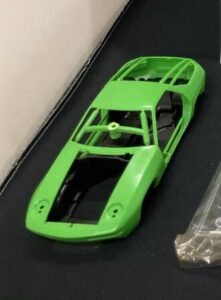
こちらの『カエル緑』のボディーは田宮版と比べると、かなり小ぶりに感じるんですが、上から見た時(プランビュー)の後部(おしり)にかけての広がりが、田宮版より強調されており、色気のあるヒップラインに子供ながらに「凄いものを見てしまった!」と感銘を受けておりました。(笑)
今思えば私の立体造形に対する好奇心はこの時新たな展開を見せ、この緑の928の未組み立てのボディーが後の奇異な造形への偏愛の原型を作ったといっても過言ではないようです。
その後大学時代に通学途中のタシロ模型にて、ドイツレベル製の1/16?と米国レベル製1/25のキットも入手しましたがボディー造形もその他のディテールもイマイチだったと記憶しています。
さらに時代が進んで、最近ではキットよりもダイキャスト製やレジン製のミニカーが出始めましたね。こんな感じで、
*Spark製、1/43 Porche 928 (メタリック・ブルーで格子柄のシート)
ーーー>めちゃくちゃ出来がよさそうで、色も年式も好みで、これが一番欲しいです。(EBAYでもなかなか見かけません、、、)
*Spark製、1/43 Porche 928S (シルバーにバーガンディー内装)
ーーーーー>今回の写真を撮ったミニカーです。
*ミニチャンプス/マキシチャンプスからも1/43の, 928や828Sが出てました。
後、小粒ですが、デッサンと彫りがしっかりしている、
*HERPA製, 1/87 Porche 928(鉄道模型用でプラスチック製)
ーーーーーー>今回の写真撮影の候補でしたがSPARK製のものが届いたので、、、
*残念なのは、京商が1/64でオリジナル版928を出してないことですね!
(1/64 928S4は出ているんですが、マイナー後の丸顔/エアロ付きのS4には、全く関心がないので、、、泣)
こんな感じで、私と928の『立体模型関係』は続いていきます。
(願わくば、最近勢いのある、中小の中国メーカーが『完璧版928』を出してくれるといいのですが。GFCCのBMW507のような、、、)
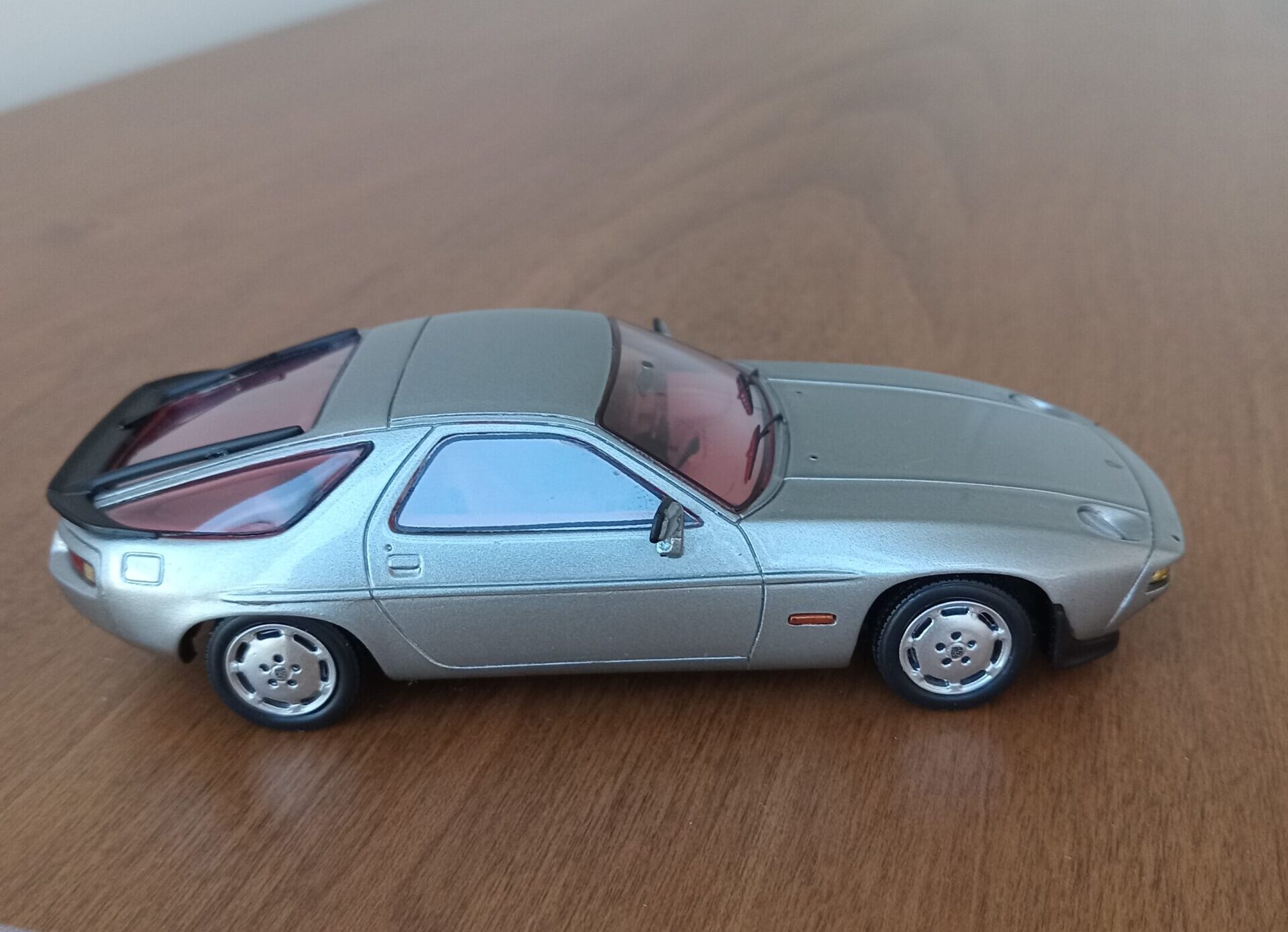
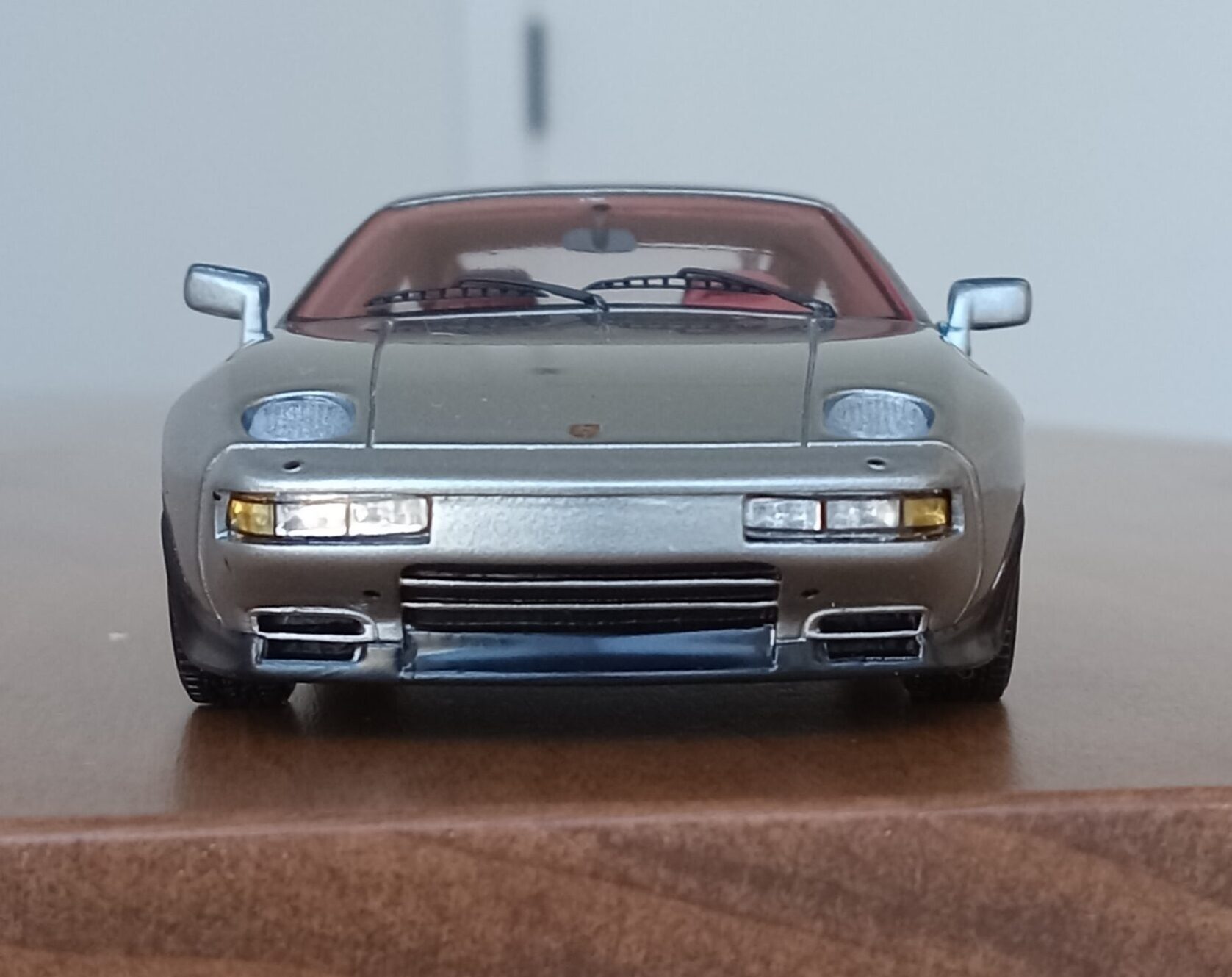
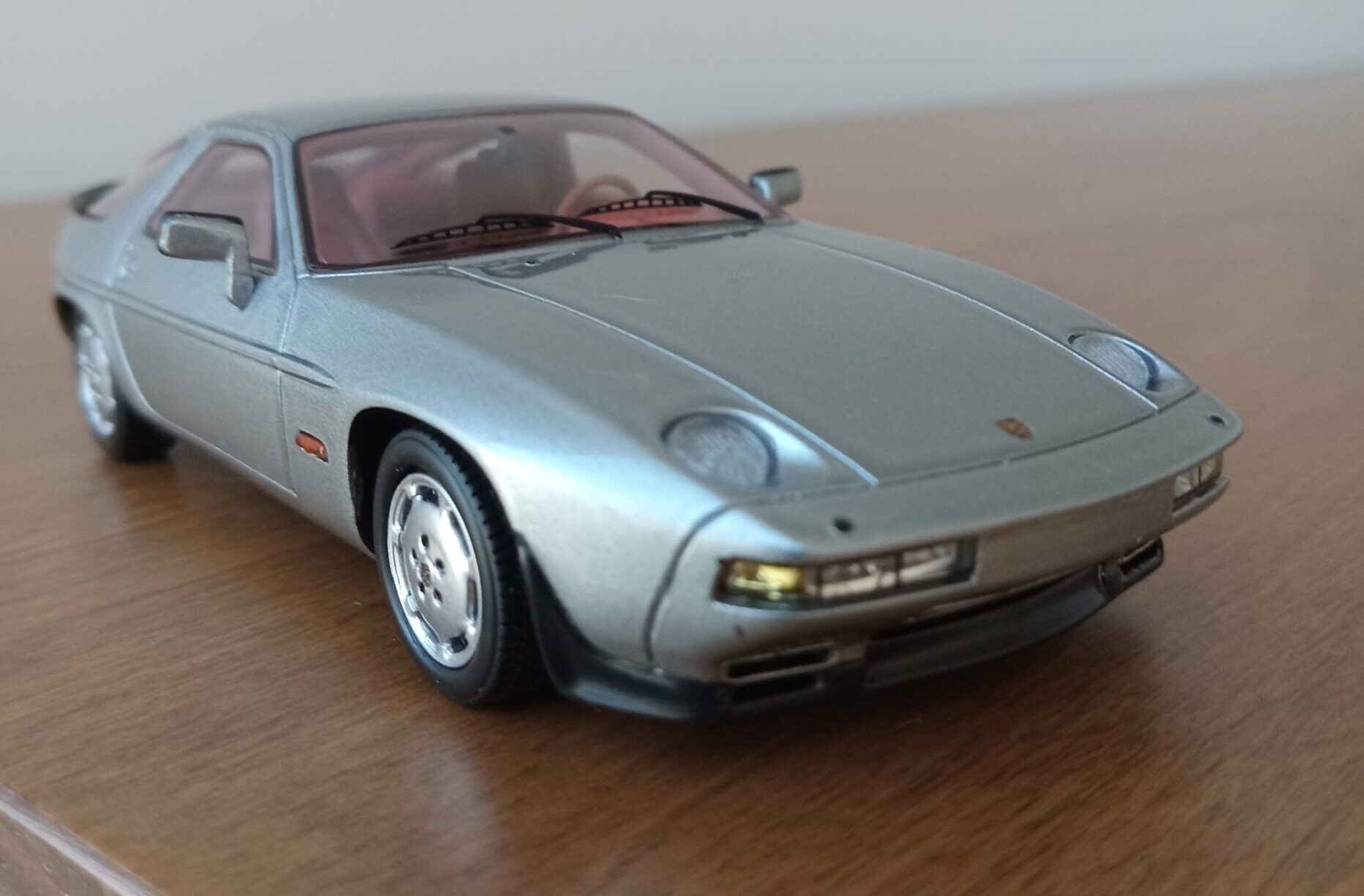
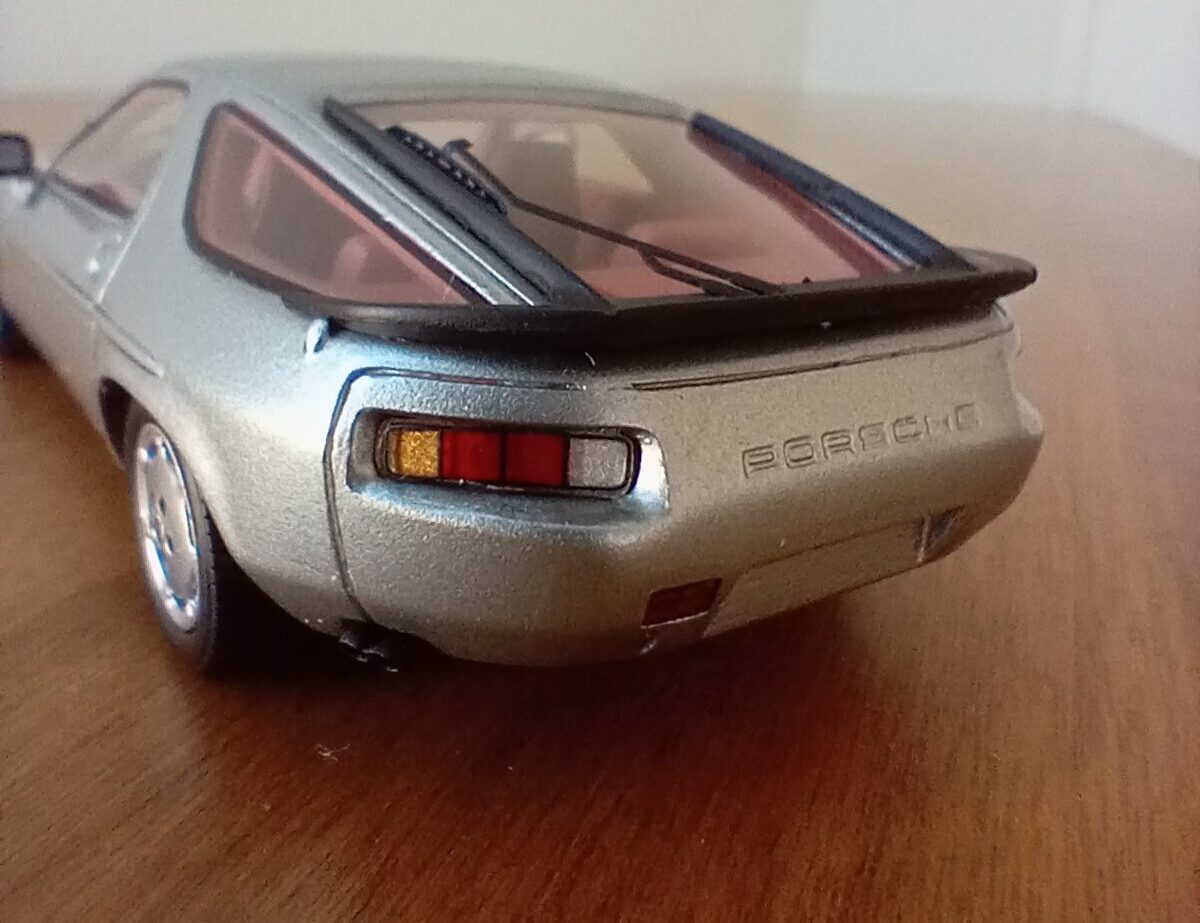
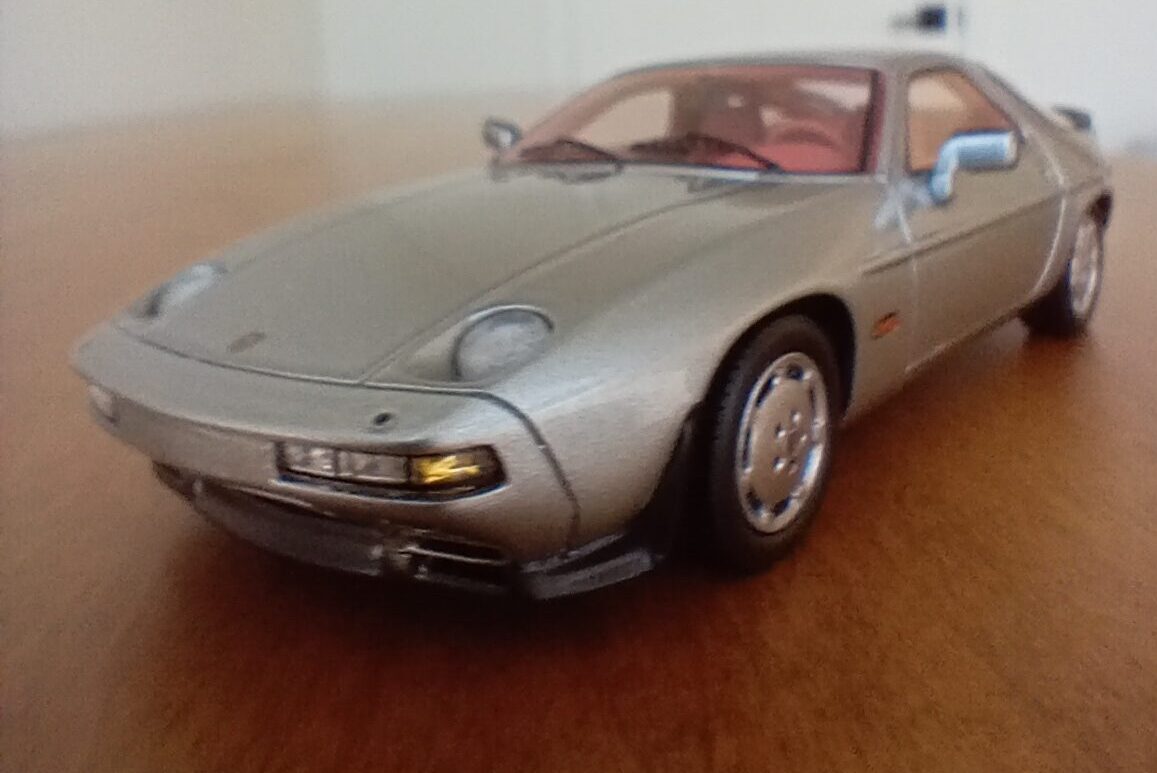
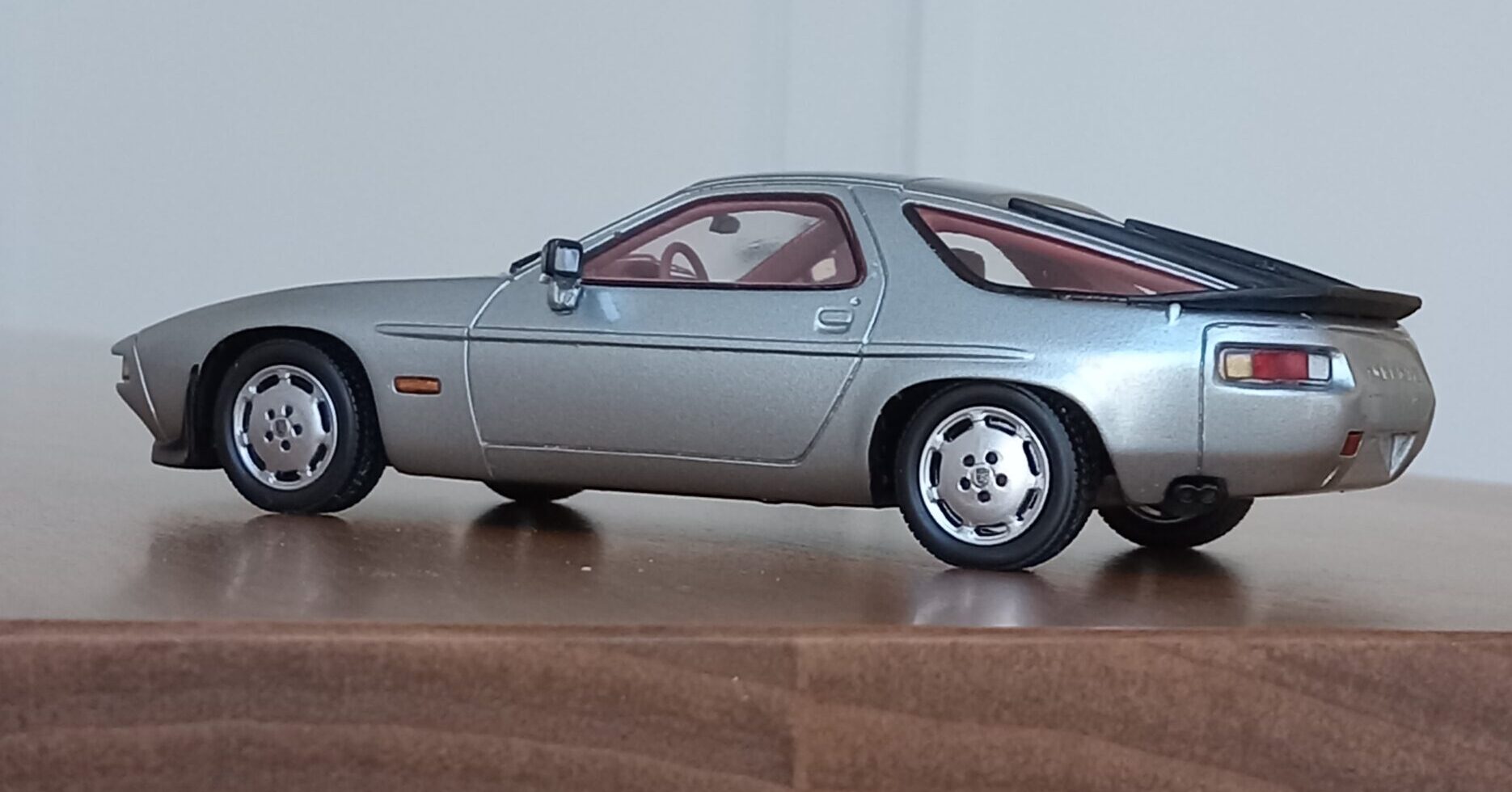
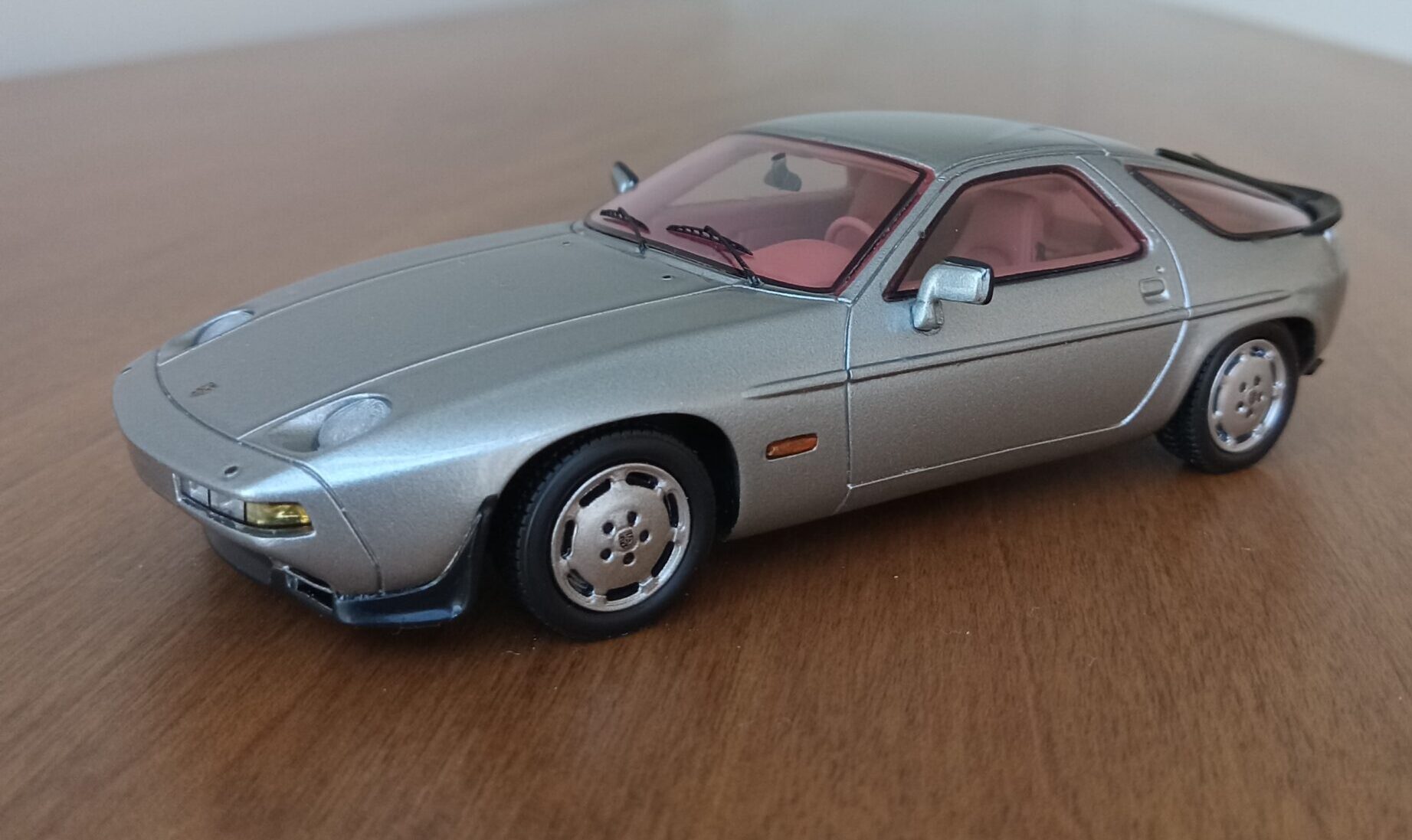
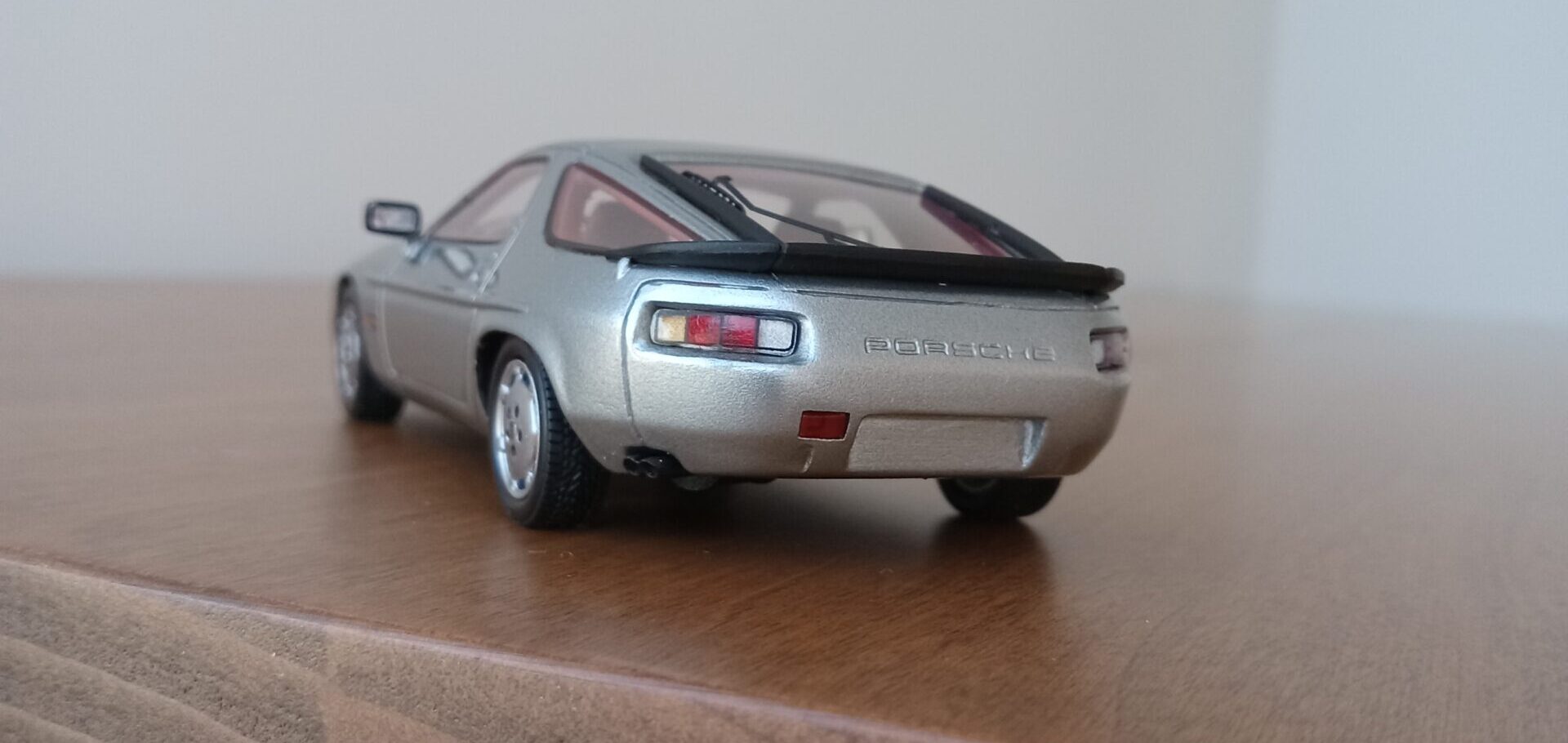
総論:
まとめてみますと、
私にとっての
ポルシェ928のデザインとは、
『宇宙的スケールの外装』と
『異次元クオリティーの内装をまとった』
『異性から来たエイリアン』となります。
(内装と外装のどちらも強力に出来がいい自動車は本当にまれですよね。)
また、
1.来たり来る、オーガニック曲面デザインの先駆者として、
2.また、GTカーならではの豪華で先進的な内装のお手本として、
3.最近になり復活のきらいがある、逆スラントノーズの見本として、
後世のデザインに与えた影響は計り知れません。
そして何より、
その冒険心あふれる、物おじしないデザイン信念の力強さは、
このデザインを一目見て『ピン』と来た人には、言葉にならない励ましをあたえ続けることでしょう!
それにしてもヨーロッパメーカーが、アメリカ向けに作った自動車には前衛的なものや、型にはまらない傑作車が多いのは気のせいでしょうか?
その他の『地球外生命体的クルマ』たち
ポルシェ 928以外で私が気になる、
『曲面ボディーで奇想天外な外装を包んだ傑作車』を並べてみますと、
こんな感じです。
*コンセプト版、ギア・フォーカス、1992 (ガンメタリック)
(1990年代当時の自動車デザイン学生のアイドル的存在、外装の昆虫的な面づくり+手工芸品的な気品が漂う内装デザインのハーモニーが作り出す、「これで決まり!」感は別格)
*初代トヨタ・プレビア、1990 (メタリック・バーガンディー)
(未来から来た「卵」みたいな、かわい・カッコイイ外観とは裏腹に、世界でただ一つのミッドシップのミニバンといったパッケージも同様に驚異的!)
*レクサス・LC500、2017 (メタリック・バーガンディー)
(トヨタのハイソ・カー黄金期のシンボル『ソアラ』一族の末裔、絶滅危惧種の大型大排気量のGTクーペではありながら、その複雑な面構成によるボディー造形は秀逸)
*初代(だるま)セリカ‣クーペ(メタリック・ターコイズ)
(64年型マスタングなどからの影響で企画された日本版「ポニー・カー」第一号、本家を超えるほどに磨き抜かれた、立体感と方向感にあふれる「におい」のあるデザイン。)
*ミツビシ・『i/アイ』,2006 (クール・シルバー・メタリック)
(創造性豊かなエンジンレイアウトによる、「超人的」パケージが産んだ、ミツビシ版「かわいい卵」、同じ「卵型」のトヨタプレビアと違い、商業的に成功しなかったのが本当に残念。ぜひ一度乗ってみたい車のひとつです。)
以上となります。
次回は、いよいよ第2位のランボルギーニ・カウンタック LP400について考察してみたいです。(特異なチュブラー・フレームについても語ります。)
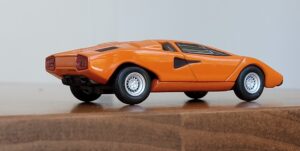
ーお楽しみにー
本ブログと記事内容につきまして:
ブログ記事を書くにあたり私の目標は、立体造形(料理も含めて)とのかかわりを通じて、私個人の特徴的(ネジ曲がり方も含めて)な評価軸を解明することで、「美しさ・美味しさ」に対する好奇心や、探求心を、どのように満足・充足させてきたのかを明記しておくことです。
従いまして、記事の中に出てくる、数字や年号、微細なデータなどには細心の注意を払っておりますが、時に大きな間違いや勘違いを犯していることも考えられます。特に自動車記事における主要諸元や、年号などには紛らわしいものも多く、あくまで参考程度に考えていただければ幸いです。
私としては、記事の中で個人的な外観デザインや味覚の評価、そこから広がる後半部分につなげるための、『流れ』を作るための客観的材料として年号やデータを挿入している感じです。あくまで重視したいのは、私個人の頭の中で起こる、記憶の錯そう的混沌から生まれる新たな『見方』や『情報の予想外のつながり』です。その勢いを作り出す、『流れ』の一環として、諸データが副次的に必要となるわけです。
話がそれますが、大好きな落語の世界に「三題噺」という、その場て会場から募った3つのお題を使って1つのお話に仕立てるといったお遊びがございますが、私はそれに近いことを立体造形の特徴や(料理のお味)をお題にして行っている感じがします。その中で頭の中に去来する数々の着想が、全く予想外で楽しく、次回からの記事内容を大幅に変えたり、新展開につながっています。
当ブロブの仕組み:
『好奇心の点と線 x 気まぐれ脳内回路=予想外の新展開』
こんな自分勝手なブログですが、今後ともよろしくお願いいたします。
追記:上記の『流れ』を作る為に必要な写真はできる限り、個人所有のミニカー・自前の料理などを使い撮影しておりますが、その他の必要最小限の図版や写真を他のブログ主様の記事や諸会社ホームページなどからお借りしております。(記事内容に合うよう加工させていただき、使用時は最小の解像度で載せております。)問題がある場合、ご連絡いただければ直ちに降ろさせていただきます。
追記2:当ブログ記事に掲載のミニカー写真等(個人撮影)は許可なしで、どのようにお使いいただいても結構です。私個人の創造性はこの世のもの、と言う認識の上で記事を製作しています。
!!!!!!!!!!!!!!!!!!!!!!!!!!!!!!!!!! Translation in English !!!!!!!!!!!!!!!!!!!!!!!!!!!!!!!!!!!!!
Top 10 Design List
Here is my subjective (lol)
top 10 list of automobile designs.
10th place: BMW 507, 1956 ———————— (Silver + matching hardtop)
9th place: AM General Hummer H1, 1992 —— (Military woodland camouflage)
8th place: MB 560 SEL, W126 model, 1979 —————— (Two-tone black and blue-gray)
7th place: Cadillac Eldorado, 1967 (Metallic blue with black leather top)
6th place: Toyota Prius, 2003 (2nd generation) —————————– (Seaside Pearl)
5th place: Honda S660, 2015 ——————— —————— (Star White Pearl)
4th place: Porsche 928, 1978 ————- (Light Blue Metallic with checkered interior)
3rd place: Citroën DS23 Pallas, 1973 ———————— (Champagne Gold)
2nd place: Lamborghini Countach LP400, 1974 ——————ーー (Orange)
1st place: Austin-Healey 100/4 (BN/1), 1953 – (Ivory and dark blue two-tone)
This time, I will talk about the general evaluation of the 4th place, the 1977 Porsche 928, and my personal experience with the 928. (All the models in the photos are 928S models. I couldn’t find any suitable 928 models, so please forgive me.)
4th place: Porsche 928, 1977
Every time I think of the Porsche 928,
the 20th Century Fox tagline,
“In space, no one can hear you scream!”
swirls around in my head. (Laughs) It’s the catchphrase from Ridley Scott’s classic sci-fi horror film, “Alien, 1979,” but
the “slimy” feel of the alien’s head in the movie
and the “slimy” feel of the Porsche 928’s body top
feel almost identical to me.
That’s how much the 928 evokes
an alien-like allure and
and it sparks my curiosity.
Encountering an unknown extraterrestrial life form that doesn’t speak Japanese or English
has prompted me to grow at an unprecedented level,
leading me to master a new design language
and discover the “otherworldly” within myself.
Actual car commentary: A replacement for the 911? A new generation of mavericks
(SPARK 1/43 Porsche 928S (Silver) Porsche Museum Special Version)
In 1972, while Porsche and the Piech family temporarily withdrew from the front lines of management, Anatole Rapain, who was in charge of design under Bill Mitchell at GM Design in the United States, was invited to Porsche by Larry Shinoda, and under his direction, the 928 was announced in 1977 as a collaboration between Harm Lagaay and Wolfgang Mebius.
The exterior design they created was a long-nose, fastback hatchback with a front-engine, rear-wheel-drive layout, completely different from the rear-engine, rear-wheel-drive 911 sports car. Specifically, it had an organic form (composed of smooth surfaces) that was unfamiliar at the time, and its bold and unique appearance, which could be described as “extraterrestrial,” had never been seen or imagined before, thoroughly stimulating the viewer.
Technologically, it was a showcase of cutting-edge innovations, including an advanced rear suspension system called the “Weissach Axle,” a rear-mounted transmission (with the battery also housed there), a tilt system that moves the steering column up and down, a futuristic “T”-shaped cockpit design, and air vents on the door sides. These features went on to become standards in subsequent models.
Ultimately, the Porsche 928 won the 1978 ‘European Car of the Year’ award (the only sports car to do so) and was produced for 18 years, with a total of 61,056 units manufactured. Its advanced exterior and meticulously engineered mechanical systems have garnered a global fan base, and it continues to be driven enthusiastically by collectors and enthusiasts today.
Selection Reasons: Objectively speaking,
When examining the Porsche 928’s exterior in detail,
it featured the following (bold and unconventional) design characteristics:
* 1990s aerodynamic shape:
The exterior design pioneered organic design
(a “smooth” body shape that preceded the second “aerodynamic/streamlined” boom of the 1980s, which focused on CD values, by 10 years)
* Front and rear views with completely different characters (viewed from above)
—————->
From the front: A striking shark face
(The front end of the face is sharply cut off at an inverted angle, combined with inorganic, recessed headlights, creating a whale-like face)
From the rear: A three-dimensional alien mask?
(The bumper and taillights are wrapped in a new urethane-based material, creating a distinctive, memorable, and highly original three-dimensional design)
* Like the outer wings of a beetle,
the rear quarter windows gently wrap around the tail section from the outside.
(There are few other examples, perhaps the AMC/Pacer’s rear window?)
* Trapezoidal design motifs
(Trapezoidal motifs overflow across the entire body: bumper lights, front window, side windows, door mirrors, tail lights, etc.)
* An abundance of interior design motifs that defy description.
# Tilt-type meter cluster
# A cockpit design with a T-shaped, flowing center that evokes a sense of envelopment
# Innovative checkered seat material selection
# Ultra-thick doors connected to air vents via ducts
(This influenced the interior design of later models like the Fairlady Z, Honda Prelude, and NSX.)
My story with the 928: A personal narrative told through Gunze and Tamiya plastic models
My encounter with the Porsche 928 began
during the supercar boom when I was in middle school,
alongside Tamiya and Gunze plastic models.
Even as a child, I handled these incomprehensible three-dimensional objects every day,
determined to find my preferred angle,
I examined it from various angles, feeling frustrated,
and suddenly shifted my perspective from the previously one-sided side view (two-dimensional)
to a three-dimensional view encompassing 360 degrees, or rather, a universal perspective encompassing all phases and directions.
Yes, that’s it—the existence of a universal perspective.
*The first one I obtained was
Tamiya’s, 1/20 metallic blue box art version,
which was released as part of the 1/20 Grand Prix Collection. Compared to the previously standard 1/24 kits, it had nearly twice the volume, and the already satisfying tactile quality of the body was even more remarkable. I would touch it and examine it every night before bed, engaging in a solitary “assembly-free conversation/runner juice (as a substitute for alcohol).” (laughs)
*The next one I acquired was
Gunze Industry’s masterpiece: the 1/24 Deluxe Series? 928.
This is an ultra-deluxe item that allows you to display the “hood, doors, and rear hatch of the car model x 1” separately from the “V8 engine, rear section connected via a propeller shaft integrated with the transaxle, and tires x 4.”
The “frog green” body of this model feels much smaller compared to the Tamiya version, but the rear (tail) section, when viewed from above (plan view), is more emphasized than the Tamiya version, and as a child, I was deeply impressed by the sensual hip line, thinking, “I’ve seen something amazing!” (laughs)
Looking back, my curiosity about three-dimensional modeling took a new turn at this time, and it’s no exaggeration to say that this unassembled green 928 body laid the foundation for my later obsession with unusual designs.
Later, during my university days, I purchased a 1/16-scale German Level kit and a 1/25-scale U.S. Level kit at Tashiro Model on my way to school, but I recall that the body design and other details were lackluster.
As time progressed, die-cast and resin miniatures began to appear more frequently than kits. For example,
*Spark 1/43 Porsche 928 (metallic blue with checkered seats)
——> This one looks amazing, and the color and model year are exactly what I want. It’s the one I want most. (It’s rare to find on eBay…)
*Spark, 1/43 Porsche 928S (silver with burgundy interior)
→ This is the mini car I photographed this time.
*Mini Champs/Maxi Champs also released 1/43 scale 928 and 828S models.
Additionally, although it’s small, the design and detailing are solid.
*HERPA-made, 1/87 Porsche 928 (plastic model for railway use)
———> This was a candidate for the photo shoot, but the SPARK-made one arrived…
*Unfortunately, Kyosho hasn’t released an original 1/64-scale 928!
(The 1/64 928S4 is available, but I have no interest in the post-facelift round-faced/aerodynamic S4… sigh)
This is how my relationship with the 928 in terms of three-dimensional models continues.
(I hope that the small and medium-sized Chinese manufacturers that are gaining momentum recently will release a ‘perfect version of the 928,’ like GFCC’s BMW 507…)
Summary:
To summarize,
for me,
the design of the Porsche 928 is
an “alien from another dimension”
wrapped in “cosmic-scale exterior”
and “otherworldly quality interior.”
(Cars with both powerful exteriors and interiors are truly rare, aren’t they?)
1. As a pioneer of organic curved surface design,
2. As a model of luxurious and advanced interior design unique to GT cars,
3. As a reference for the recently revived reverse slant nose design,
its influence on future designs is immeasurable.
And above all,
the bold, fearless strength of its design philosophy,
will continue to inspire those who instantly connect with this design in ways that words cannot express!
Still, is it just a coincidence that European manufacturers often produce avant-garde or unconventional masterpieces when designing cars for the American market?
Other ‘extraterrestrial-like cars’
Besides the Porsche 928, here are some other cars that catch my eye,
masterpieces with curved bodies and unconventional exteriors:
Here’s what they look like.
*Concept version, Gear Focus, 1992 (Gunmetal)
(An idol among automotive design students in the 1990s, the harmony between the insect-like exterior and the artisanal elegance of the interior design creates an unparalleled sense of “this is it!”)
*First-generation Toyota Previa, 1990 (Metallic Burgundy)
(Despite its cute and cool “egg-like” appearance, the packaging of the world’s only mid-ship minivan is equally astonishing!)
* Lexus LC500, 2017 (Metallic Burgundy)
(Descendant of the “Soarer” family, the symbol of Toyota’s golden age of luxury cars, now an endangered species)
*First generation (Daruma) Celica Coupe (Metallic Turquoise)
(The first Japanese version of the “pony car,” inspired by the 1964 Mustang, with a refined design that surpasses the original, full of three-dimensionality and directionality.)
* Mitsubishi ‘i/Eye’, 2006 (Cool Silver Metallic)
(A “superhuman” package born from a creatively designed engine layout, this is Mitsubishi’s version of the “cute egg.” Unlike the similarly egg-shaped Toyota Previa, it unfortunately failed to achieve commercial success. It’s one of those cars I’d really like to drive someday.)
That concludes this article.
Next time, I would like to explore the Lamborghini Countach LP400, which ranks second. (I will also discuss its unique tubular frame.)
—Stay tuned—
Translated with DeepL
これはCTAサンプルです。
内容を編集するか削除してください。

